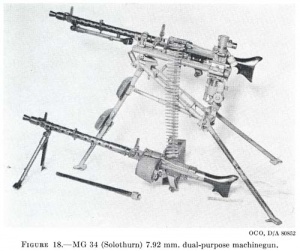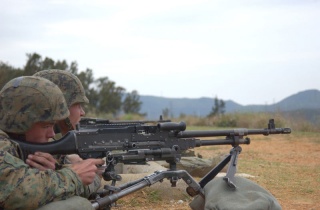General purpose machine gun

A general purpose machine gun (GPMG) in concept is a multi-purpose weapon, a machine gun intended to fill the role of either a light machine gun or medium machine gun, while at the same time being man-portable. However, performance in either role may be inferior to a weapon specifically designed for that role. In modern practice, they are air-cooled medium machine guns firing rifle cartridges such as the 7.62x51mm NATO. They are generally operated from a stationary prone position from either a bipod or tripod, or mounted on a vehicle, as they are usually too powerful and heavy to be fired effectively on foot from an unsupported standing position or on the move.
The term GPMG (or "Jimpy" in British Army slang), which comes from the Belgian-French name Mitrailleuse d'Appui General or General Purpose Machineguns (GPMG), became popular for describing medium machine guns used in multiple roles. The original Belgian-French term Mitrailleuse a Gaz is also known to be used. The mediums fired rifle caliber ammunition, but had some concessions for more extended firing and more general usage. This generally included both bipod and tripod/pintle mounting options and quick-change barrels. The first medium machine gun used as a GPMG traces back to World War I, where aircooled medium machine guns were used in many different roles, typically with larger magazines on aircraft, tanks, and ships, and in lighter configurations by infantry on bipods or tripods.
During the inter-war period, Germany developed the Maschinengewehr 34, or MG34, from scratch as a GPMG, as opposed to an adaptation of an existing weapon, such as the MG08/15. The MG34 was air-cooled, belt-fed and had the ability to be mounted on a variety of fixtures and employed in several different roles. Notably, the MG34 remained the standard co-axial weapon for Nazi German vehicles through the Second World War. The MG34 was successful enough during use in the opening stages of the Second World War that the concept of the GPMG was adopted in many other post-WWII armies. The MG 34's immediate successor in Wehrmacht service, the MG42, was the most versatile and effective machine gun design of the Second World War. The MG3, a direct descendant of the MG42, is still in service with the German Army and others.
The Belgian FN MAG, FN Mitrailleuse d'Appui General (general purpose machine gun) has long been the most widely-used GPMG among NATO and other western armies. The British Army and other Commonwealth forces used it to replace the venerable Vickers Gun, beginning in the late 1950s. It is known as the "Gympy"(Sometimes spelt "Jimpy") in British Army slang.

The US Army has adopted the FN MAG as the M240 to replace the previous US GPMG (also widely used by allied nations), the M60 machine gun. The US Army uses the M249 - the MINIMI - as its light machine gun/squad automatic weapon, and the M2 machine gun (using the .50 BMG cartridge) is used in the heavy machine gun role.
In the late 1956, the Canadian Military adopted the FN MAG as the C6A1 GPMG along with the purchase of the FNC1 and FNC2's. Even though the C1's and the C2's have been replaced by the C7A1/ C7A2 rifle and the C9A1/ C9A2 LMG, the C6 is still used as a GPMG and is held in such high regard in the Canadian Army that 2 are deployed in each Platoon's Weapon detachment. Due to the need of a Heavy machine gun, the Browning .50 Cal has been brought back into service with the Canadian Army.
Since the late 1950s or early 1960s, the Czechs produced the vz. 59 general purpose machine-gun in both 7.62x54mmR and 7.62 mm NATO (for export models), for which light and heavy barrels were made for differing tactical roles. The approximate Russian equivalent is the PK/PKM family of multi-purpose machine-guns which has been in Russian, and previously Soviet, military service since 1964, and which has been widely exported.
Since 1967, the People's Republic of China has also produced a general purpose machine-gun in 7.62x54mmR as a hybrid weapon derived from several different machine-gun models and with the original model designation of Type 67; since then, second and third modified and improved models of this gun have been made and have been designated Type 67-1 and Type 67-2 respectively.